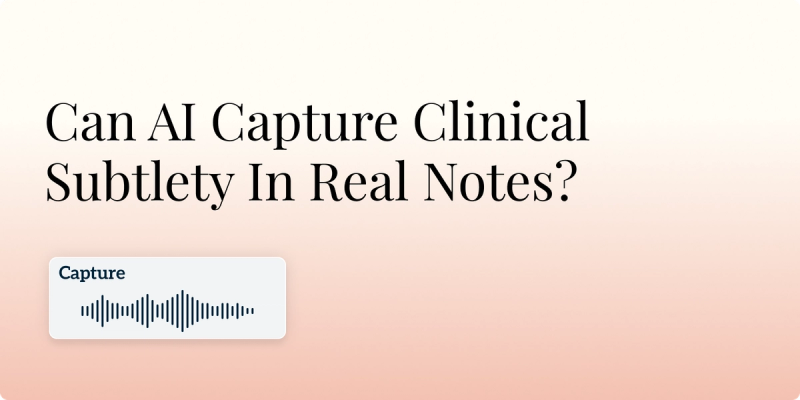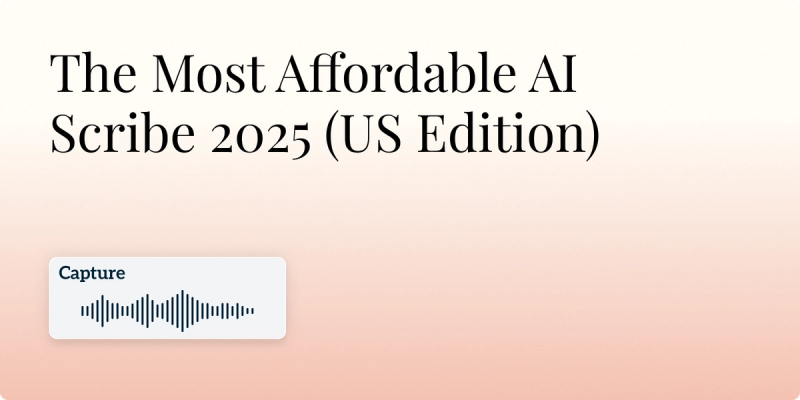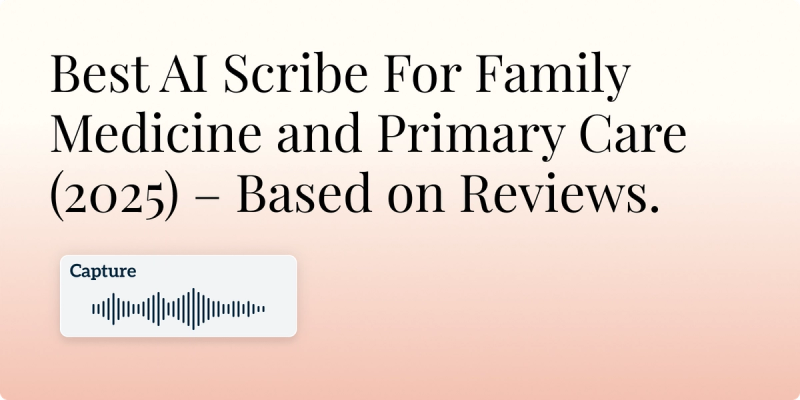
Can AI Capture Clinical Subtlety In Real Notes?

Within a clinical note, the most critical information often lies not in the structured data, but in the subtle threads woven between the lines: the hesitant qualifier, the specific metaphor, or implied diagnostic uncertainty. This is the domain of clinical subtlety: the nuanced context that transforms raw data into a coherent patient story and guides expert medical judgement. As AI medical scribes for clinicians increasingly handle documentation, a crucial question emerges: Can these tools truly learn to interpret the deeply human layer of meaning required for clinical subtlety in AI notes?
This exploration moves beyond whether AI can simply transcribe words, and asks if it can grasp their clinical significance. Explore the technical capabilities of natural language processing, examine where AI succeeds in identifying nuance, and confront the limitations it faces in capturing clinical subtlety.
Defining The ‘Clinical Subtlety’ Gap: What Are We Actually Talking About?
The foundation of clinical reasoning extends far beyond the structured data of codes and vitals. It resides in the nuanced, often unquantifiable information that gives raw data its meaning. This is the clinical subtlety gap where AI often stumbles.
The Power Of Implicit Meaning
True clinical understanding requires interpreting what is meant, not just what is said. This layer of subtext is where human expertise shines and where AI faces its toughest challenge.
Hedged Language and Uncertainty
Clinicians routinely use calibrated language to express diagnostic confidence. The difference between “findings suggestive of early CHF” and “findings consistent with CHF” represents a gradient of certainty. A human reader understands the first implies an initial hypothesis, while the second aligns more strongly with a working diagnosis. An AI without specific training on these linguistic nuances might treat both phrases as identical positive indicators for congestive heart failure, losing the dimension of uncertainty.
Loaded Patient Quotes
Patient language is often layered with implication. A statement like “I tried to take my medication” rarely means simple effort. To a clinician, it strongly implies partial or complete non‑adherence, hinting at underlying barriers like side effects, cost, or doubt. The question is whether an AI can be trained to flag the word “tried” as a high‑priority signal for potential adherence issues, rather than treating it as a neutral verb.
Narrative Context
A single phrase like “patient is well-known to this practice with a complex psychiatric history” carries a dense weight of unspoken context for a human. It signals an established therapeutic alliance, a potentially complicated medication regimen, and a history that may influence present‑day symptom presentation. A “naive” AI might see this as a simple demographic statement, entirely missing its implications for diagnostic caution and clinical management.
How AI Attempts to Bridge the Gap
To navigate these subtleties, modern AI medical scribes employ techniques that move far beyond simple keyword searches.
Natural Language Processing
Modern NLP aims to understand with grammatical and contextual awareness. The goal is to parse full sentences to extract entities, attributes, and relationships, effectively understanding the “who, what, when, where, and how” of clinical text.
- Example: An advanced NLP model can process the sentence, “The patient denies chest pain but reports a ‘sharp, stabbing’ sensation in the left shoulder.”
- It would correctly encode:
- Chest_pain: absent
- Shoulder_pain: present
- Pain_quality: sharp, stabbing
- Pain_location: left shoulder
This allows the system to logically handle negation and qualify multiple, distinct patient reports.
Sentiment and Tone Analysis
This technique attempts to quantify the emotional subtext within language. Using algorithms trained on labeled datasets, AI can assess the emotional valence of text, categorizing it as negative, positive, anxious, or fearful.
- Example: When analyzing a patient's direct quotes in a therapy note, an AI could flag passages with a high density of ‘negative sentiment’ or ‘anxiety-related lexicon’ (e.g, worried, afraid, overwhelmed). It wouldn't diagnose, but it could highlight these sections for the clinician's immediate attention, ensuring subtle cues of distress aren't overlooked in a lengthy narrative.
Clinical Language Models (CLMs) and Contextual Embeddings
These are AI models specifically trained on medical corpora to understand the latent relationships between clinical concepts. CLMs learn a mathematical representation of medical knowledge, allowing them to understand that certain concepts are clinically related, even if they are not explicitly linked in the text.
- Example: a CLM reading a note containing “elevated troponin”, “STEMI on ECG”, and “crushing substernal chest pain” would recognize the clinical relationship between these three findings, as they strongly point toward an acute myocardial infarction. It can infer the connection based on its training, much like a medical student develops clinical pattern recognition.
The Inherent Limitations: Where AI Still Falls Short
Despite these advanced techniques, AI medical scribes for clinicians lack human embodied experience, creating persistent gaps in understanding.
The Common Sense Problem
AI models operate on statistical correlations in data, not real‑world cause‑and‑effect reasoning.
- Example: an AI might perfectly identify that a “patient is a retired carpenter” and that the same patient has “chronic lower back pain”. However, without being explicitly trained on occupational medicine, it would likely fail to infer a plausible causal link between decades of physical labor and the presenting condition, a connection any human would immediately consider.
The Nuance Of Negation And Hedging
While NLP has improved, complex linguistic structures that convey uncertainty remain a challenge.
- Example: A phrase like “The chance of infection cannot be ruled out” is a classic hedge, meaning infection is considered possible but not confirmed. A less sophisticated model might misinterpret the phrase, focusing on “infection” and “ruled out” and incorrectly concluding that an infection is present, completely inverting the clinical meaning.
The Black Box Problem
The reasoning process of complex AI models can be unclear. Even when an AI correctly identifies a clinical subtlety, it can be difficult or impossible to understand how it reached that conclusion. In medicine, where accountability is important, the inability to explain a finding (“Why did you flag this as high-risk?”) limits trust and clinical utility. The “why” is often non‑negotiable.
The Future: Human-AI Partnership
The most promising path forward leverages the strengths of both human and AI.
Concept Of ‘AI-Assisted’ Subtlety
The goal of clinical subtlety in AI notes is a tool that augments human expertise. In this model, the AI acts as a radar, scanning vast amounts of data for potential signals of nuance, where the human clinician then interprets and acts upon.
AI As A Highlight Reel
Imagine an AI that pre‑processes a long, complex consult note and provides the following summary for the busy clinician:
- “Potential implied non-adherence in Subjective: Review patient quote: ‘I try to be good with my pills’”
- “Contradiction noted: Documented flat affect contrasts with patient's self-report of ‘feeling great’”
- “Key finding highlighted: Critical potassium level of 5.9mEq/L is buried in the middle of the Objective section.”
This transforms the AI from a note‑taker into a clinical assistant that directs attention to what matters most.
Proactive Prompting For Nuance
Clinicians can also guide the AI to look for specific subtleties. Instead of a passive command like “transcribe this,” a clinician could proactively prompt:
- “Analyze this conversation for language suggestive of underlying health anxiety.”
- “Flag any statements that might indicate reservations about the treatment plan.”
- “Identify the primary coping mechanism the patient describes.”
This interactive loop allows the clinician to prioritize clinical subtlety in AI notes as a focused extension of their reasoning, bridging the subtlety gap through a collaborative partnership.
Conclusion
AI medical scribes’ ability to capture clinical subtlety remains a spectrum, not a simple yes or no. Through advanced NLP, it can now effectively flag potential nuances, like hesitant language or emotional sentiment, acting as a powerful radar that scans for patterns human eyes might miss.
However, interpreting the clinical significance of these signals requires human wisdom, context, and common sense that AI currently lacks. The most powerful future lies in a collaborative partnership: AI as the radar, the clinician as the decision‑maker. This bridge between data‑driven signals and expert judgment is where true potential for nuanced, efficient, and accurate clinical documentation will be realized.
Frequently Asked Questions
ABOUT THE AUTHOR
Dr. Danni Steimberg
Licensed Medical Doctor
Reduce burnout,
improve patient care.
Join thousands of clinicians already using AI to become more efficient.

The Most Affordable AI Scribe 2025 (US Edition)
See 2025 US pricing for popular AI scribes. Twofold Health leads on affordability at $49/mo (annual) with unlimited notes, undercutting Freed, Heidi, and Scribeberry.

Can An AI Scribe Keep Up With A 15-Minute Visit?
Can AI truly document a fast-paced patient visit? Explore the capabilities and limits of AI medical scribes in real-world settings.

Best AI Scribe For Family Medicine and Primary Care (October 2025) – According to Real Reddit Reviews
Family‑medicine docs compare 9 AI scribes on Reddit. See pros, cons, and pricing—and learn why Twofold Health tops the list for primary‑care notes in 2025.

